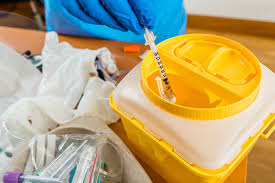Proper management and disposal of medical waste are essential components of maintaining a safe and healthy environment within healthcare facilities.

Safe disposal of medical waste is a shared responsibility that requires cooperation and adherence to established protocols by healthcare workers, facility administrators, waste management personnel, and regulatory authorities. From hospitals to clinics, laboratories to dental offices, all healthcare settings generate various types of medical waste that require careful handling and disposal to prevent the spread of infections and protect both healthcare workers and the general public.
By implementing best practices for waste segregation, containment, disinfection, and disposal, healthcare facilities can effectively mitigate the risks associated with medical waste and contribute to a safer and healthier environment for all.
Understanding Medical Waste:
Medical waste encompasses a wide range of materials, including used needles, syringes, bandages, surgical gloves, blood-soaked dressings, laboratory cultures, and discarded medical equipment. This waste may contain infectious agents such as bacteria, viruses, or other pathogens, making safe disposal procedures critical.
Guidelines for Safe Disposal:
Training and Awareness: Healthcare facilities should provide comprehensive training to staff members on proper waste management and disposal practices. All personnel should be familiar with facility-specific protocols and equipped with the necessary knowledge and resources to handle medical waste safely.
Segregation and Categorization: Medical waste should be segregated at the point of generation to facilitate proper disposal. Common categories of medical waste include infectious waste, sharps, pathological waste, pharmaceutical waste, and hazardous chemical waste. Segregation helps ensure that each type of waste is handled and disposed of appropriately.Personal Protective Equipment (PPE): Healthcare workers involved in the handling or disposal of medical waste must wear appropriate PPE, including gloves, masks, gowns, and eye protection. PPE helps prevent direct contact with potentially hazardous materials and reduces the risk of exposure to infectious agents.
Containment and Packaging: Medical waste should be contained in leak-proof, puncture-resistant containers that are specifically designed for the type of waste being disposed of. Sharps containers, biohazard bags, and rigid containers are commonly used for different types of medical waste. Containers should be securely sealed to prevent spills or leaks during handling and transport.
Disinfection and Decontamination: Surfaces and equipment that come into contact with medical waste should be thoroughly cleaned and disinfected using appropriate disinfectants. This includes work surfaces, storage areas, and reusable medical equipment. Decontamination procedures help minimize the risk of cross-contamination and ensure a safe working environment.
Transportation and Disposal:
- Medical waste should be transported and disposed of in accordance with local regulations and guidelines. Licensed medical waste disposal companies should be engaged to collect, transport, and dispose of medical waste safely and legally. Disposal methods may include incineration, autoclaving, chemical treatment, or landfilling, depending on the type of waste and regulatory requirements.

Documentation and Record-Keeping: Healthcare facilities should maintain accurate records of medical waste generation, handling, and disposal activities. Documentation helps ensure compliance with regulatory requirements, track waste volumes, and identify areas for improvement in waste management practices.






No comments:
Post a Comment